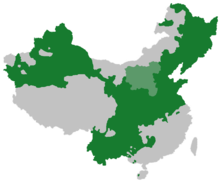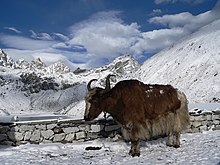Wikijunior:Asia/China

China (Chinese: 中华人民共和国, People's Republic of China) is a country in East Asia ruled by the Chinese Communist Party (CCP). It is also known as the People's Republic of China, because Taiwan is called the Republic of China. China has the largest population of any country in the world: 1.357 billion. With an area of 3,705,407 square miles, it is either the third largest (after Russia and Canada) or fourth largest (after Russia, Canada, and the United States) country in the world (depending on how the landmass is counted). China's capital is Beijing, its current CCP general secretary and president is Xi Jinping, and current premier is Li Qiang, and the national currency is the Chinese Renminbi.
Where is China?
[edit | edit source]

China is in eastern Asia. Meeting the country's eastern coastline is the South China Sea (a part of the Pacific Ocean). To the north, China borders Russia, Mongolia, and North Korea. To the west, Kazhakstan, Kyrgyzstan, Tajikistan, and Afghanistan. To the southwest, Pakistan, India, Nepal, and Bhutan, and to the southeast, Burma, Laos, and Vietnam.
How many people live in China?
[edit | edit source]1,357,380,000 people live in China, making it the most populated country in the world! That's about 20% of the entire population of the world, which means that about 1 person out of 5 people is Chinese! Most of these people (91.5%) are ethnic Han, and most of them live in the east and south in big cities like Shanghai, Beijing, and Hong Kong. The other 8.5% of the population is made up of ethnic minorities.
This may seem like a small number, but because China is so big, 8.5% is over 110 million people. This is more than the population of any European country (except Russia)! The biggest of the 56 ethnic minorities (those with over 5 million members) are:
- The Zhuang (17 million) live in southern China near Vietnam and speak a group of languages related to Thai and Lao.
- The Hui (11 million) live all around China. They speak Mandarin and are ethnically similar to the Han, but are Sunni Muslims.
- The Manchu (10 million) live in Manchuria and historically spoke Manchu, but now mostly speak Mandarin. The Qing dynasty, which ruled China from 1644 to 1912, was of Manchu origin.
- The Uyghur (10 million) are the largest ethnic group in Xinjiang, in the far northwest. They speak a language related to Turkish and are Sunni Muslims.
- The Miao (9 million in China) are a minority in the south and speak the Miao language. The Hmong people are a subgroup of the Miao who also live in Vietnam (1 million) and Laos (.5 million).
- The Yi (8 million) are a minority in central and southern China. They speak Yi, a language related to Burmese.
- The Tujia (8 million) live in the Wuling Mountains in central China.
- The Tibetans (7 million) live in Tibet, where they form the majority. They live in the Himalayan Mountains, the largest mountain range in the world. There is a strong independence movement in Tibet.
- The Mongols (6 million in China) live in Inner Mongolia, their traditional homeland, where they are 17% of the population. There are almost twice as many Mongols in China as in Mongolia, where there are only 3 million, although they are a majority there.
Leaders and governments
[edit | edit source]China is an authoritarian state ruled by the Chinese Communist Party (CCP). The "paramount leader" is the General Secretary of the Communist Party, who holds several other offices including ceremonial President.
The current CCP general secretary and president is Xi Jinping, and the current premier is Li Keqiang.
China has been always been a Communist nation (one that favors the Communist way of working) since its independence in 1949 and has always been ruled by the Communist Nation of China. But there are some significant restrictions on this:
- Only the Communist Party or its smaller alliances (smaller supporting parties) can contest for the elections, even if it is legal to form other parties.
- Only approved members can contest for the election.
In contrast, China-managed Hong Kong has significant freedoms to this, including rights of press and more. However, in 2014, a major protest broke out when China's government announced that in 2017, unlike what was promised, only approved contestants can become the president.
What are the most common languages in China?
[edit | edit source]
The official language of China is Mandarin Chinese, and is spoken by 70% of the population. It is spoken as a first language in the central and east parts of the country.
The rest of the population speaks almost 300 other languages, including the other languages in the Chinese language family: Yue (including Cantonese) in the far south around Guangzhou, Hong Kong, and Macau; Wu in the east around Shanghai; Min Nan in Fujian; Hakka, Gang, and Xiang in the south; and many other smaller languages.
There are also non-Chinese languages spoken by ethnic minorities: Tibetan in Tibet (in the far southwest); Uyghur, Kazakh, and Tajik in the northwest; Mongolian in Inner Mongolia (in the north); English in Hong Kong; Portuguese in Macau; and many, many other languages.
What is the most common religion in China?
[edit | edit source]China is home to many different religions. Traditionally, the most important religions in Chinese culture have been what are known as the three teachings: Buddhism, Confucianism, and Taoism. These are all somewhere between religions and philosophies, and have traditionally overlapped with each other and with traditional folk religion. Since the boundaries between religion, philosophy, and tradition is unclear in China, it is hard to say how many people subscribe to which religions.
Aside from the three teachings and the folk religions, there are several religious minorities in China, notably Christianity, Islam, and Tibetan Buddhism.
What sports are played in China?
[edit | edit source]Some sports that are widely played in China are badminton and football. Ping Pong would usually be played in free time. China has been long associated with martial arts, and most of China's main sports are combative sports. Football (associates football/soccer) is currently the most popular team sport in China. They are some fast growing sports in China, such as cricket, which has established itself in Hong Kong, a former British Colony. The Chinese Cricket Association has set goals for itself for the next 14 years, one of them being Qualified for the World Cup by 2019. China hosted the 2014 Youth Olympic Games.
What are some important sights?
[edit | edit source]

China is a very large country, and has a large number of sights to see. Along with Italy, China leads the world with 55 UNESCO World Heritage Sites.
- The Great Wall of China (or 长城/万里长城, in Chinese), a UNESCO Historical Site since 1987, is one of the greatest wonders of the world. The Great Wall of China stretches from east to west China, and goes through grasslands, mountains, and deserts. The Great Wall of China is approximately 13,170 miles (21,196 kilometers) long. Tho, through the 2,000+ years, sections of the Great Wall of China are now in ruins or have disappeared. But nonetheless, the Great Wall of China is still one of the most fascinating structures in the world, with about 4,000 million people visiting each year. It is also one of the only structures clearly visible from the space.
- The Forbidden City (or Palace Museum; or 故宫博物馆、紫禁城) was the imperial palace for 24 emperors during the Ming and Qing Dynasty. The "Forbidden City" lies at the city center, and as well is called Gu Gong in Chinese. Ancient Chinese Astronomers thought that the "Purple Star", Polaris, was in the center of heaven. It was forbidden to enter the city without special permission from the emperor, hence "The Forbidden City". Forbidden City is north of the Tienanmen Square in Beijing. Rectangular, this palace museum is the largest complex in the world. The Palace Museum is full of 8,700 rooms.
- Mount Everest (Chomolungma (mother goddess of the universe) in Tibet; Sagarmatha (goddess of the sky) in Nepal) is the highest land mountain on Earth, and is on the boarder of Tibet (China) and Nepal. Tenzing Norgay (1953) and Edmund Hillary (1953) where the first to climb Mount Everest, specifically May 29. Mount Everest is 29,000+ feet high/8,800+ meters high, and grows a quarter of an inch each year. Mount Everest is the highest mountain in the world, above K2 (2nd highest mountain; in China-Pakistan Border; 28,500+ feet high/8,600+ meters high) and Kangchenjunga (3rd highest mountain; in Sikkim, India, partly in Nepal; 28,100+ feet high/8,500+ meters high). Mount Everest is over 60 million years old, and can reach from -80 to over 100F.
 |
Wikijunior:Asia | edit | |

